EPICANCER—Cancer Patients Presenting to the Emergency Departments in France: A Prospective Nationwide Study
Abstract
1. Introduction
2. Patients and Methods
2.1. Objectives
2.2. Patients and Study Design
2.3. Statistical Analysis
3. Results
3.1. General Characteristics and Reasons for Seeking Emergency Care
3.2. Presentation at Inclusion
3.3. Access to the Oncologic Medical Record
3.4. Investigations, Interventions and Treatments
3.5. Outcome after ED Visit and at Day 30
3.6. Sensitivity Analyses
4. Discussion
Limitations
5. Conclusions
Supplementary Materials
Author Contributions
Funding
Acknowledgments
Conflicts of Interest
References
- Howlader, N.; Noone, A.M.; Krapcho, M.; Miller, D.; Bishop, K.; Kosary, C.L.; Yu, M.; Ruhl, J.; Tatalovich, Z.; Mariotto, A.; et al. SEER Cancer Statistics Review, 1975–2014; National Cancer Institute: Bethesda, MD, USA, 2014.
- Defossez, G.; Le Guyader-Peyrou, S.; Uhry, Z.; Grosclaude, P.; Colonna, M.; Dantony, E.; Delafosse, P.; Molinié, F.; Woronoff, A.S.; Bouvier, A.M.; et al. Estimations nationales de l’incidence et de la mortalité par cancer en France métropolitaine entre 1990 et 2018. In Etude à Partir des Registres des Cancers du Réseau Francim. Résultats Préliminaires. Synthèse; Saint-Maurice: Santé Publique, France, 2019. [Google Scholar]
- Samphao, S.; Eremin, J.; Eremin, O. Oncological emergencies: Clinical importance and principles of management. Eur. J. Cancer Care 2009, 19, 707–713. [Google Scholar] [CrossRef] [PubMed]
- Peyrony, O.; Shapiro, N.I. The 10 signs telling me that my cancer patient in the emergency department is at high risk of becoming critically ill. Intensiv. Care Med. 2018, 44, 2315–2318. [Google Scholar] [CrossRef] [PubMed]
- Shapiro, C.L. Cancer Survivorship. N. Engl. J. Med. 2018, 379, 2438–2450. [Google Scholar] [CrossRef] [PubMed]
- Brown, J.; Grudzen, C.R.; Kyriacou, D.N.; Obermeyer, Z.; Quest, T.; Rivera, D.; Stone, S.; Wright, J.; Shelburne, N. The Emergency Care of Patients With Cancer: Setting the Research Agenda. Ann. Emerg. Med. 2016, 68, 706–711. [Google Scholar] [CrossRef] [PubMed]
- Greene, J. CONCERN for Cancer: New National Institutes of Health Network to Focus on Cancer Patients in the Emergency Department. Ann. Emerg. Med. 2015, 66. [Google Scholar] [CrossRef] [PubMed]
- Rivera, D.R.; Gallicchio, L.; Brown, J.; Liu, B.; Kyriacou, D.N.; Shelburne, N. Trends in Adult Cancer-Related Emergency Department Utilization: An Analysis of Data From the Nationwide Emergency Department Sample. JAMA Oncol. 2017, 3, e172450. [Google Scholar] [CrossRef] [PubMed]
- Hsu, J.; Donnelly, J.; Moore, J.X.; Meneses, K.; Williams, G.R.; Wang, H.E. National characteristics of Emergency Department visits by patients with cancer in the United States. Am. J. Emerg. Med. 2018, 36, 2038–2043. [Google Scholar] [CrossRef]
- Jairam, V.; Lee, V.; Park, H.S.; Thomas, C.R.; Melnick, E.R.; Gross, C.P.; Presley, C.J.; Adelson, K.B.; Yu, J.B. Treatment-Related Complications of Systemic Therapy and Radiotherapy. JAMA Oncol. 2019, 5, 1028–1035. [Google Scholar] [CrossRef]
- Taboulet, P.; Moreira, V.; Haas, L.; Porcher, R.; Braganca, A.; Fontaine, J.-P.; Poncet, M.-C. Triage with the French Emergency Nurses Classification in Hospital scale: Reliability and validity. Eur. J. Emerg. Med. 2009, 16, 61–67. [Google Scholar] [CrossRef]
- Chevret, S.; Seaman, S.; Resche-Rigon, M. Multiple imputation: A mature approach to dealing with missing data. Intensiv. Care Med. 2015, 41, 348–350. [Google Scholar] [CrossRef]
- White, I.R.; Royston, P.; Wood, A.M. Multiple imputation using chained equations: Issues and guidance for practice. Stat. Med. 2011, 30, 377–399. [Google Scholar] [CrossRef] [PubMed]
- Kerrouault, E.; Denis, N.; Le Conte, P.; Dabouis, G. Improving organization of care could reduce referrals of cancer patients to the emergency department. Prospective analysis of 123 patients. Presse Med. 2007, 36, 1557–1562. [Google Scholar] [CrossRef] [PubMed]
- Van Der Meer, D.M.; Weiland, T.; Philip, J.; Jelinek, G.; Boughey, M.; Knott, J.; Marck, C.H.; Weil, J.L.; Lane, H.; Dowling, A.; et al. Presentation patterns and outcomes of patients with cancer accessing care in emergency departments in Victoria, Australia. Support. Care Cancer 2015, 24, 1251–1260. [Google Scholar] [CrossRef] [PubMed]
- Sadik, M.; Ozlem, K.; Huseyin, M.; AliAyberk, B.; Ahmet, S.; Ozgur, O. Attributes of cancer patients admitted to the emergency department in one year. World J. Emerg. Med. 2014, 5, 85–90. [Google Scholar] [CrossRef]
- Oatley, M.; Fry, M.; Mullen, L.; Information, P.E.K.F.C. A cross-sectional study of the clinical characteristics of cancer patients presenting to one tertiary referral emergency department. Int. Emerg. Nurs. 2016, 24, 35–38. [Google Scholar] [CrossRef]
- Bingisser, R.; Dietrich, M.; Ortega, R.N.; Malinovska, A.; Bosia, T.; Nickel, C. Systematically assessed symptoms as outcome predictors in emergency patients. Eur. J. Intern. Med. 2017, 45, 8–12. [Google Scholar] [CrossRef]
- Kuster, T.; Nickel, C.H.; Jenny, M.A.; Blaschke, L.L.; Bingisser, R. Combinations of Symptoms in Emergency Presentations: Prevalence and Outcome. J. Clin. Med. 2019, 8, 345. [Google Scholar] [CrossRef]
- Säfwenberg, U.; Terént, A.; Lind, L. The Emergency Department presenting complaint as predictor of in-hospital fatality. Eur. J. Emerg. Med. 2007, 14, 324–331. [Google Scholar] [CrossRef]
- Möckel, M.; Searle, J.; Muller, R.; Slagman, A.; Storchmann, H.; Oestereich, P.; Wyrwich, W.; Ale-Abaei, A.; Vollert, J.O.; Koch, M.; et al. Chief complaints in medical emergencies. Eur. J. Emerg. Med. 2013, 20, 103–108. [Google Scholar] [CrossRef]
- Swenson, K.K.; A Rose, M.; Ritz, L.; Murray, C.L.; A Adlis, S. Recognition and Evaluation of Oncology-Related Symptoms in the Emergency Department. Ann. Emerg. Med. 1995, 26, 12–17. [Google Scholar] [CrossRef]
- Mayer, D.K.; Travers, D.; Wyss, A.; Leak, A.; Waller, A. Why Do Patients With Cancer Visit Emergency Departments? Results of a 2008 Population Study in North Carolina. J. Clin. Oncol. 2011, 29, 2683–2688. [Google Scholar] [CrossRef] [PubMed]
- VanDyk, A.; Harrison, M.B.; Macartney, G.; Ross-White, A.; Stacey, D. Emergency department visits for symptoms experienced by oncology patients: A systematic review. Support. Care Cancer 2012, 20, 1589–1599. [Google Scholar] [CrossRef] [PubMed]
- Karakoumis, J.; Nickel, C.H.; Kirsch, M.; Rohacek, M.; Geigy, N.; Müller, B.; Ackermann, S.; Bingisser, R. Emergency Presentations With Nonspecific Complaints—the Burden of Morbidity and the Spectrum of Underlying Disease. Medicine 2015, 94, e840. [Google Scholar] [CrossRef] [PubMed]
- Azoulay, E.; Mokart, D.D.; Pène, F.F.; Lambert, J.; Kouatchet, A.; Mayaux, J.; Vincent, F.; Nyunga, M.; Bruneel, F.; Laisne, L.-M.; et al. Outcomes of Critically Ill Patients With Hematologic Malignancies: Prospective Multicenter Data From France and Belgium—A Groupe de Recherche Respiratoire en Réanimation Onco-Hématologique Study. J. Clin. Oncol. 2013, 31, 2810–2818. [Google Scholar] [CrossRef]
- Soares, M.; Caruso, P.; Silva, E.; Teles, J.M.M.; Lobo, S.M.A.; Friedman, G.; Dal-Pizzol, F.; Mello, P.V.C.; Bozza, F.A.; Silva, U.V.A.; et al. Characteristics and outcomes of patients with cancer requiring admission to intensive care units: A prospective multicenter study*. Crit. Care Med. 2010, 38, 9–15. [Google Scholar] [CrossRef]
- Azoulay, E.; Pène, F.F.; Darmon, M.; Lengliné, E.; Benoit, D.; Soares, M.; Vincent, F.; Bruneel, F.; Perez, P.; Lemiale, V.; et al. Managing critically Ill hematology patients: Time to think differently. Blood Rev. 2015, 29, 359–367. [Google Scholar] [CrossRef]
- Berger, T.; Green, J.; Horeczko, T.; Hagar, Y.; Garg, N.; Suarez, A.; Panacek, E.; Shapiro, N. Shock Index and Early Recognition of Sepsis in the Emergency Department: Pilot Study. West. J. Emerg. Med. 2013, 14, 168–174. [Google Scholar] [CrossRef]
- Kristensen, K.B.; Holler, J.G.; Hallas, J.; Lassen, A.; Shapiro, N.I. Is Shock Index a Valid Predictor of Mortality in Emergency Department Patients With Hypertension, Diabetes, High Age, or Receipt of β- or Calcium Channel Blockers? Ann. Emerg. Med. 2016, 67, 106–113.e6. [Google Scholar] [CrossRef]
- Daniels, L.M.; Durani, U.; Barreto, J.N.; O’Horo, J.C.; Siddiqui, M.A.; Park, J.G.; Tosh, P.K. Impact of time to antibiotic on hospital stay, intensive care unit admission, and mortality in febrile neutropenia. Support. Care Cancer 2019, 27, 4171–4177. [Google Scholar] [CrossRef]
- Peyrony, O.; Dumas, G.; Legay, L.; Principe, A.; Franchitti, J.; Simonetta, M.; Verrat, A.; Amami, J.; Milacic, H.; Bragança, A.; et al. Central venous oxygen saturation is not predictive of early complications in cancer patients presenting to the emergency department. Intern. Emerg. Med. 2018, 14, 281–289. [Google Scholar] [CrossRef]
- Kim, M.; Kim, W.Y.; Sohn, C.H.; Seo, D.W.; Lee, Y.-S.; Lim, K.S.; Ahn, S. Predictive performance of the quick Sequential Organ Failure Assessment score as a screening tool for sepsis, mortality, and intensive care unit admission in patients with febrile neutropenia. Support. Care Cancer 2017, 25, 1557–1562. [Google Scholar] [CrossRef] [PubMed]
- Doukhan, L.; Bisbal, M.; Chow-Chine, L.; Sannini, A.; Brun, J.P.; Cambon, S.; Duong, L.N.; Faucher, M.; Mokart, D.D. Respiratory events in ward are associated with later intensive care unit (ICU) admission and hospital mortality in onco-hematology patients not admitted to ICU after a first request. PLoS ONE 2017, 12, e0181808. [Google Scholar] [CrossRef] [PubMed]
- Mokart, D.D.; Lambert, J.; Schnell, D.; Fouché, L.; Rabbat, A.; Kouatchet, A.; Lemiale, V.; Vincent, F.; Lengliné, E.; Bruneel, F.; et al. Delayed intensive care unit admission is associated with increased mortality in patients with cancer with acute respiratory failure. Leuk. Lymphoma 2012, 54, 1724–1729. [Google Scholar] [CrossRef] [PubMed]




| Variable | Missing Data | |
|---|---|---|
| ED, No | 138 | |
| Patients Included, No | 1380 | |
| No of Patients Included by Center | 0 | |
| Mean | 10 | |
| Median | 8 | |
| IQR | 4–14 | |
| Max | 40 | |
| Prevalence, % | 17 | |
| Mean | 3.1 | |
| Median | 2.8 | |
| IQR | 1.7–4.0 | |
| Max | 11.1 |
| Variable | Missing Data (n) | |
|---|---|---|
| N | 1380 | |
| Age (Years), Median (IQR) | 71 (61–82) | 30 |
| Female Gender, n (%) | 598 (43.6) | 8 |
| Underlying Malignancy, n (%) | 4 | |
| Solid Malignancy | 1185 (86.1) | |
| Digestive and pancreas | 223 (18.8) | |
| Breast | 187 (15.8) | |
| Prostate | 175 (14.8) | |
| Lung | 172 (14.5) | |
| Kidney and bladder | 117 (9.9) | |
| Endometrium and ovary | 61 (5.1) | |
| Head and neck | 57 (4.8) | |
| Skin | 55 (4.6) | |
| Other | 138 (11.7) | |
| Hematologic Malignancy | 191 (13.9) | |
| Lymphoma | 73 (38.2) | |
| Chronic leukemia | 38 (19.9) | |
| Myeloma | 37 (19.4) | |
| Acute leukemia | 22 (11.5) | |
| Other | 21 (11.0) | |
| Time Since Diagnosis, n (%) | 122 | |
| <6 months | 236 (18.8) | |
| 6 months–5 years | 753 (59.9) | |
| >5 years | 269 (21.3) | |
| Disease Status, n (%) | 285 | |
| Complete remission | 270 (24.7) | |
| Partial remission | 354 (32.3) | |
| Uncontrolled malignancy | 471 (43.0) | |
| Metastatic, n (%) | 380 (47.1) | 573 |
| Specific Treatments in the Last 3 Months, n (%) | 134 | |
| Chemotherapy | 401 (32.2) | |
| Hormonotherapy | 127 (9.2) | |
| Radiotherapy | 73 (5.9) | |
| Surgery | 65 (5.2) | |
| Immunotherapy | 47 (3.8) | |
| Other | 17 (1.4) | |
| Poor Performance Status (>2), n (%) | 283 (24.3) | 213 |
| Patient Alone at Home, n (%) | 225 (27.7) | 569 |
| Home Nursing Service or Nursing Home Care, n (%) | 483 (37.3) | 85 |
| Variables at ED Presentation | Missing Data (n) | |
|---|---|---|
| N | 1380 | |
| Critically Ill According to the Emergency Physician, n (%) | 102 (8.3) | 144 |
| Respiratory failure | 44 (3.6) | |
| Shock | 44 (3.6) | |
| Altered mental status | 19 (1.5) | |
| High Shock-Index a (≥1), n (%) | 130 (9.9) | 71 |
| Triage Level, n (%) | 373 | |
| 1 | 50 (5.0) | |
| 2 | 205 (20.3) | |
| 3 | 520 (51.6) | |
| 4 | 200 (19.9) | |
| 5 | 32 (3.2) | |
| Pain Assessment at ED Arrival | 1029 (74.6) | |
| NPRS ≥ 6 | 213 (20.7) |
| Variable | Missing Data (n) | |
|---|---|---|
| N | 1380 | |
| Exams, n (%) | 0 | |
| None | 113 (8.2) | |
| Blood sample | 1057 (76.6) | |
| X-ray | 602 (43.6) | |
| CT-scan | 358 (25.8) | |
| ECG | 158 (11.4) | |
| Ultrasound | 68 (4.9) | |
| Other | 36 (2.6) | |
| Interventions, n (%) | 0 | |
| Peripheral catheter | 1008 (73.0) | |
| Oxygen therapy | 204 (14.8) | |
| Fluid challenge | 164 (11.9) | |
| Puncture/drainage/catheterization | 88 (6.4) | |
| Management of traumatism | 43 (3.1) | |
| Non-invasive ventilation/mechanical ventilation | 11 (0.8) | |
| Cardiopulmonary resuscitation | 1 (0.1) | |
| Red Cells or Platelets Transfusion, n (%) | 61 (4.4) | |
| Medications, n (%) | 0 | |
| Analgesia | 430 (31.2) | |
| Antibiotics | 193 (14.0) | |
| Morphine | 54 (3.9) | |
| Cardiovascular/coagulation | 46 (3.3) | |
| Nebulization | 25 (1.8) | |
| Sedation/neurological | 12 (0.9) | |
| Vasoactive agents | 7 (0.5) | |
| Other | 31 (2.2) | |
| Long-Term Central Venous Catheter Carrier, n (%) | 243 (23.0) | 324 |
| Use of Long-Term Central Venous Catheter, n (%) | 28 (13.4) | 34 |
| Complete Cases | After Imputation | |||
|---|---|---|---|---|
| N = 541—Deaths = 81 | N = 865—Deaths = 120 | |||
| OR (95% CI) | p | OR (95% CI) | p | |
| Male Gender | 1.96 (1.13–3.52) | 0.02 | 1.63 (1.04–2.56) | 0.03 |
| Age (≥60 years) | 1.90 (0.89–4.47) | 0.11 | 1.82 (0.93–3.53) | 0.08 |
| Fatigue | 1.75 (0.97–3.13) | 0.06 | 1.64 (1.01–2.67) | 0.049 |
| Poor Performance Status (>2) | 2.78 (1.63–4.76) | 0.0002 | 3.00 (1.87–4.80) | <0.00001 |
| Solid Malignancy a | 3.70 (1.41–12.81) | 0.02 | 3.05 (1.26–7.40) | 0.01 |
| Uncontrolled Malignancy | 2.00 (1.14–3.57) | 0.02 | 2.27 (1.36–3.80) | 0.002 |
| Neurological Disorders | 2.69 (1.34–5.28) | 0.005 | 2.38 (1.36–4.19) | 0.003 |
| High Shock-Index b (≥1) | 2.03 (1.03–3.94) | 0.04 | 1.80 (1.03–3.13) | 0.04 |
| Oxygen Therapy | 2.43 (1.34–4.37) | 0.003 | 2.68 (1.68–4.29) | <0.0001 |
© 2020 by the authors. Licensee MDPI, Basel, Switzerland. This article is an open access article distributed under the terms and conditions of the Creative Commons Attribution (CC BY) license (http://creativecommons.org/licenses/by/4.0/).
Share and Cite
Peyrony, O.; Fontaine, J.-P.; Beaune, S.; Khoury, A.; Truchot, J.; Balen, F.; Vally, R.; Schmitt, J.; Ben Hammouda, K.; Roussel, M.; et al. EPICANCER—Cancer Patients Presenting to the Emergency Departments in France: A Prospective Nationwide Study. J. Clin. Med. 2020, 9, 1505. https://doi.org/10.3390/jcm9051505
Peyrony O, Fontaine J-P, Beaune S, Khoury A, Truchot J, Balen F, Vally R, Schmitt J, Ben Hammouda K, Roussel M, et al. EPICANCER—Cancer Patients Presenting to the Emergency Departments in France: A Prospective Nationwide Study. Journal of Clinical Medicine. 2020; 9(5):1505. https://doi.org/10.3390/jcm9051505
Chicago/Turabian StylePeyrony, Olivier, Jean-Paul Fontaine, Sébastien Beaune, Abdo Khoury, Jennifer Truchot, Frédéric Balen, Rishad Vally, Jacques Schmitt, Kasarra Ben Hammouda, Mélanie Roussel, and et al. 2020. "EPICANCER—Cancer Patients Presenting to the Emergency Departments in France: A Prospective Nationwide Study" Journal of Clinical Medicine 9, no. 5: 1505. https://doi.org/10.3390/jcm9051505
APA StylePeyrony, O., Fontaine, J.-P., Beaune, S., Khoury, A., Truchot, J., Balen, F., Vally, R., Schmitt, J., Ben Hammouda, K., Roussel, M., Borzymowski, C., Vallot, C., Sanh, V., Azoulay, E., & Chevret, S. (2020). EPICANCER—Cancer Patients Presenting to the Emergency Departments in France: A Prospective Nationwide Study. Journal of Clinical Medicine, 9(5), 1505. https://doi.org/10.3390/jcm9051505





